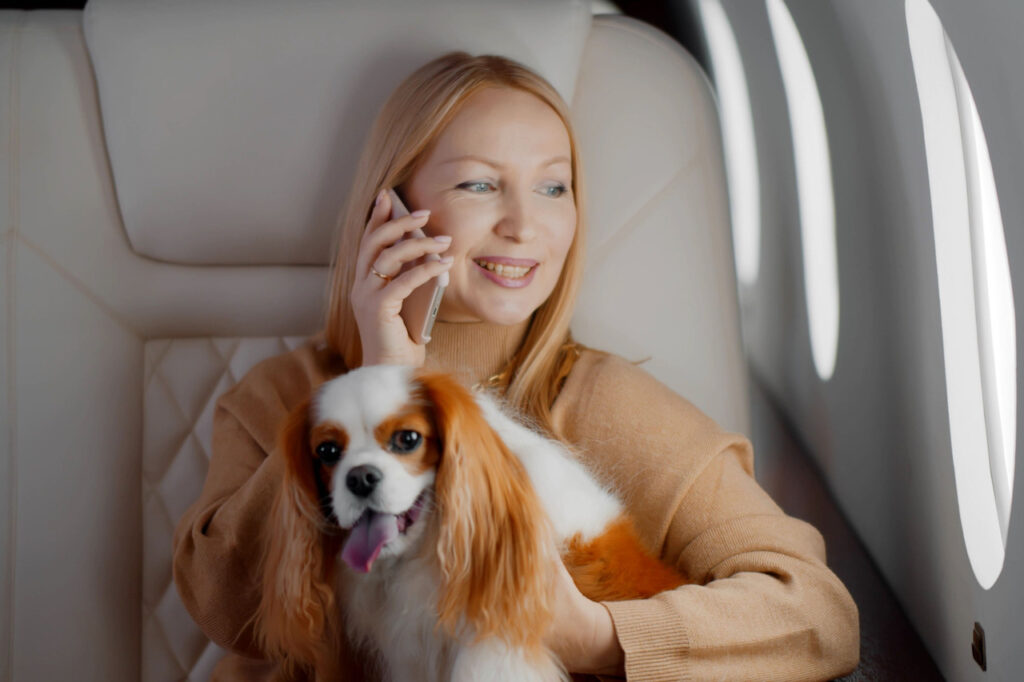
flying with a pet
While taking a pet on a trip can be an incredible thrilling adventures, but there are certain difficulties involved. Whether you’re planning a vacation or moving to a new city, knowing how to navigate the complexities of flying with your furry friend is essential for a smooth and stress-free journey. This guide will cover everything you need to know, from preparation to arrival, ensuring that both you and your pet have a comfortable and enjoyable experience.
Preparation: The Key to a Stress-Free Journey
Proper preparation is crucial when flying with a pet. This begins with understanding the airline’s pet policy, as rules and regulations can vary widely between carriers. Additionally, there may be restrictions on the types of pets allowed, as well as specific guidelines for carriers and travel documents.
Pantelis Kakaris, owner of the Adventourely, emphasizes the importance of planning ahead. “To prevent any last-minute shocks, it’s imperative to be completely informed of the regulations, as each airline has unique requirements. Make sure you book your pet’s spot as soon as possible, as there are often limited spaces available for pets on flights.”
Choosing the Right Carrier
The carrier you choose for your pet is another critical factor. It should be well-ventilated, comfortable, and spacious enough for your pet to stand, turn around, and lie down. The carrier should also comply with the airline’s size restrictions for cabin or cargo travel.
The pet care provider Wags and Willows’ Cindy Spence offers the following advice: “Choosing a suitable transport is crucial for your pet’s safe and comfortable conditions during the travel. I always recommend acclimating your pet to the carrier well in advance of the trip. Let them explore it, take naps in it, and associate it with positive experiences. This will help reduce their anxiety when it’s time to fly.”
Health and Documentation
Make sure your pet is healthy and up to date on boosters before taking a flight. Many airlines require a health certificate issued by a veterinarian within ten days of travel. This certificate should confirm that your pet is fit to fly and free from contagious diseases.
Silvia Lupone, owner of Stingray Villa, a pet-friendly travel destination, adds, “Traveling internationally with a pet adds another layer of complexity. It’s imperative to review the pet export regulations of the desired region, as they may stipulate quarantine periods or need particular vaccines. Missing even one document could result in your pet being denied entry.”
At the Airport: Navigating Check-In and Security
On the day of travel, arriving at the airport early is essential. This allows ample time for check-in, security screenings, and any last-minute adjustments. When checking in, inform the airline staff that you’re traveling with a pet and confirm all necessary arrangements.
Security Screening
During security screening, you’ll be required to remove your pet from its carrier so the carrier can be x-rayed. It’s advisable to have a harness and leash on your pet to ensure they are secure while outside the carrier. Be prepared for a potentially stressful situation, as the airport environment can be overwhelming for animals.
Cindy Spence, from Wags and Willows notes, “I always advise pet owners to remain calm and composed during the security screening process. Your pet will pick up on your energy, so if you’re stressed, they’ll be stressed too. Keep your tone soothing and reassuring, and reward your pet with treats and praise afterward.”
In the Air: Ensuring Comfort and Safety
Once on the plane, your primary focus should be keeping your pet comfortable and calm. If your pet is traveling in the cabin, place the carrier under the seat in front of you, ensuring it remains secure throughout the flight. For pets in the cargo hold, it’s essential to trust that the airline will take good care of them, but there are steps you can take to ease your mind.
Cabin Travel
If your pet is prone to anxiety, consider using a calming spray or pheromone collar to help them relax. It’s also a good idea to bring along their favorite toy or blanket to provide comfort.
Pantelis Kakaris, owner of Adventourely shares, “I’ve seen many pet owners who travel frequently with their pets find success with natural calming aids. However, it’s always best to consult with your vet before using any products to ensure they’re safe for your specific pet.”
Cargo Hold Travel
For pets traveling in the cargo hold, ensuring their safety and well-being can be more challenging. To mitigate risks, choose a direct flight whenever possible to reduce the time your pet spends in transit. Attach a label to the carrier with your contact information and details about your pet, including their name and any special instructions.
Silvia Lupone adds, “It’s vital to remember that airlines have abilities flying pets in the shipment area. However, you can take additional precautions by booking flights during cooler parts of the day and avoiding travel during extreme weather conditions.”
Arrival: Settling In
Upon arrival, your pet may be disoriented and stressed from the journey. Take some time to allow them to acclimate to their new environment. As they settle in, give them water and an opportunity to flex their legs, and offer endurance.
Cindy Spence advises, “The first few hours after arrival are crucial for your pet’s comfort. Keep things calm and familiar, and give them plenty of love and attention.
Conclusion
Flying with your pet can be a rewarding experience with the right preparation and mindset. By following these guidelines and considering expert advice from professionals like Pantelis Kakaris, Cindy Spence, and Silvia Lupone, you can ensure a smooth and stress-free journey for both you and your furry companion. Safe travels!
